|
1.
CENTRAL AND WEST AFRICA
Rain delaying operations
Operators in Gabon have been experiencing long delays in
harvesting due to heavy rain. Logging in Cameroon has
also been significantly impacted by heavy rain. The
excessive rainfall has led to some mills temporarily
reducing or ceasing operations across the region especially
in the Central African Republic and Congo.
Decline in sales of okoume
Some Chinese-owned mills have stopped production due
to the decline in sales of okoume and peeling mills in the
special economic zone are still feeling the effects of the
industrial action by workers. There are rumours in trade
circle that the government may put the special economic
zones under military control.
The new government in Gabon has taken a firm stance on
suspicions of irregularities where significant state funds
were allocated for projects but where not fully utilised for
their intended purposes. Those found to have
misappropriated funds or failed to complete projects are
required to return the money or finalsie the work paid for.
There is an ongoing effort to improve the efficiency of the
Ministry of Forestry. The new Forest Minister is
conducting visits to the provinces to evaluate operations.
Second quarter 2023 production in Gabon down
almost 30%
Lenouveaugabon.com has reported, quoting the latest
economic report from the Ministry of the Economy that at
the end of the second quarter of 2023 production by the
timber industries in Gabon was 29% lower than during the
he same period in 2022, dropping from 1.3 million cubic
metres at the end of June 2022 to 982,006 cubic metres at
the end of June 2023.
This fall, according to the same source, is the result of
logistical problems in the sector in recent months
particularly linked to recurring incidents on the railway
and the poor state of the road network during the rainy
season. These difficulties have negatively affected the
supply of factories, particularly those installed in the Nkok
special economic zone.
See:
https://www.lenouveaugabon.com/fr/agro-bois/0410-20172-industrie-du-bois-la-production-chute-de-30-au-2e-trimestre-en-raison-des-difficultes-d-approvisionnement-des-usines
Chinese buyers on the sidelines
Milling operations have slowed as mills run down log
stocks built up during the dry period. Producers report
order levels are stable but completing shipments is being
held up.
Poor weather during what was supposed to be the dry
season disrupted harvesting which is now being felt as log
yard stocks fall. The absence of Chinese buyers in the
market has contributed to lower demand.
The government has imposed tight controls on the export
of logs. Export is only possible for certain operators who
demonstrate ‘responsible’ processing.
There is no shortage of containers in Cameroon. Port
operations, particularly in Douala and Kribi, are generally
steady. Efforts have been made to better organise timber
dispatch in Douala.
Producers in Congo point to weakening prices
Heavy rain is impacting harvesting, especially in the
northern regions of the Congo. It is reported that the bad
weather extends to the northern border with Cameroon and
is seriously affecting trucking on laterite roads.
Port operations in Pointe Noire remain steady with no
significant disruptions. Order levels have been stable for
approximately two months. A log export quota system is
in operation in order to generate greater revenue, at the
same time there is pressure on millers to expand tertiary
processing.
Producers point to a softening of prices in Europe which
they suspect is linked to high landed stocks and the
cautious approach by buyers as the European winter
season approaches. Customers from countries such as
Turkey, Iraq, and Iran are not showing significant activity
as the ongoing conflicts in the region are undermining
confidence.
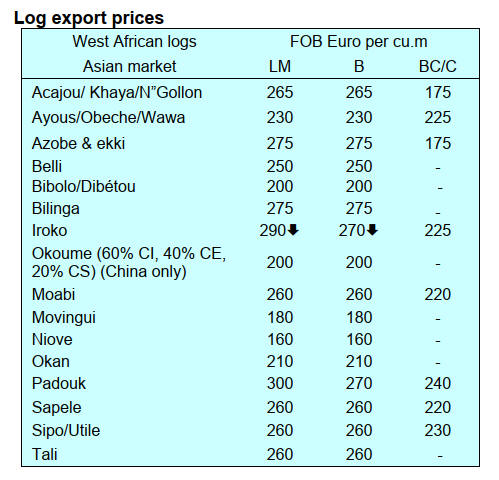
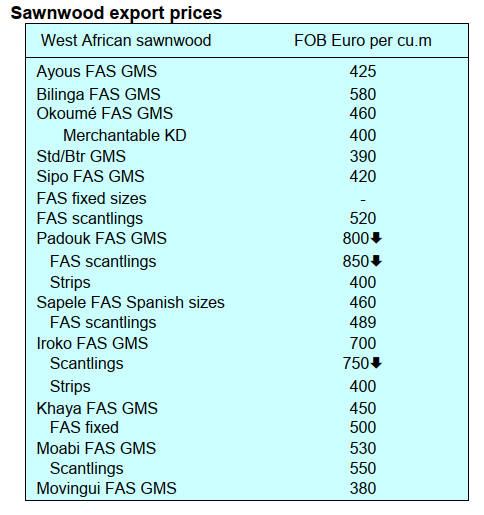
Through the eyes of industry
The latest GTI report lists the challenges identified by the
private sector in the Republic of Congo and Gabon.
See:
https://www.itto-ggsc.org/static/upload/file/20231017/1697507334917952.pdf
2.
GHANA
‘Dumsor’ (power outages) plague the country
Large areas of Ghana are facing power blackouts due to
gas shortages at a major power facility adding to the
difficulties manufacturers face due to the economic crisis
in the country.
Ghana Gas Chief Executive Officer, Ben Asante, said the
problem was related to gas delivery rather than supply,
adding that the outages occurred because the pipeline
operated by the West African Gas Pipeline Company,
responsible for transporting approximately 100 million
standard cubic feet of gas per day from Takoradi to Tema,
had been temporarily taken out of service. Ghana
partly relies on natural gas for power generation
See:
https://www.africanews.com/2023/10/27/limited-gas-supply-triggers-nationwide-power-outage-in-ghana//
Banks asked to do more for SMEs
The President has added his voice to calls for local banks
to do more to support agribusinesses (incl. forest
plantations and wood processing) describing the
agricultural sector’s share of bank loans is far too low.
The President acknowledged the current efforts being
made by the banks but said “your efforts are only
scratching the surface of the crisis in the agricultural
sector”.
He added that there are about 3.5 million farmers in the
country but the level of credit that goes into financing their
activities is not only discouraging but also the lowest in
West Africa.
See:
https://thebftonline.com/2023/10/24/akufo-addo-tells-banks-to-do-more-for-agric/
Wood product export slump
Receipts from exports of wood products in the first eight
months of 2023 slumped by 11% to Eur92.35 million
compared to the Eur103.84 million for the same period in
2022.
According to data source from the Timber Industry
Development Division (TIDD) this was because of a 14%
drop in the volume of wood products exported (205,127
cu.m) during the period in 2023 compared to 237,464
cu.m for the same period in 2022.
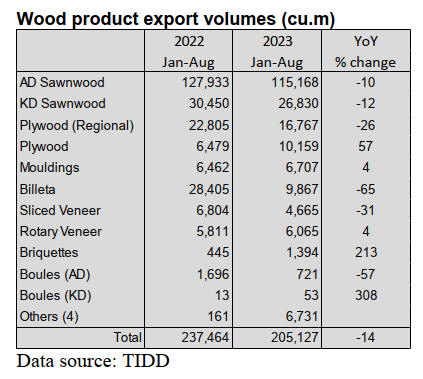
In spite of the 2023 poor overall performance export
volumes of kiln dried boules, briquettes and plywood
recorded significant increases in volume during the period
compared to the same period in 2022. The top three export
products for both 2022 and 2023 were AD and KD
sawnwood and plywood for the regional West Africa
markets. These products accounted for 168,924 cu.m and
18,188 cu.m respectively of the total export volume.
During the period under review some products also
recorded significant decreases in volumes. Their
performance in 2023 negatively affected the
corresponding revenues for the period when compared to
the previous year. Receipts from exports of billet and
veneer dropped by 67% and 37% respectively to register
Eur3.03 million in 2023 against Eur9.09 million in 2022 .
About eighty exporters contributed to the export of
seventeen wood products during the period from thirty-
eight species. The leading species included teak, ceiba,
wawa, eucalyptus and rubberwood. Demand for wood
products in Asian and African markets dropped. The major
destinations for these wood products were India, United
States of America, China, Togo and the United Kingdom.
Decline in approved contracts
The volume of approved export contract in the second
quarter of this year was 61,268 cu.m and 87,000 pieces of
bamboo. Compared to the volume during the same period
in 2022 this showed a decrease of over 40% according to
TIDD data sources.
Table below shows the total contract volume processed
and approved during the period classified into Primary,
Secondary and Tertiary products;
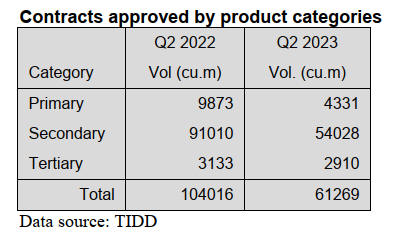
The table below shows the contracts processed and
approved by the TIDD offices in Takoradi, Tema, Kumasi
and Sunyani in the second quarter of 2023;

The highest contract volume was processed and approved
in Takoradi followed by Kumasi with Sunyani and Accra
accounting for less than 5%.
New member for Forestry Commission board
The new Executive Secretary of Lands Commission,
Benjamin Arthur, has been sworn in as a new member of
Forestry Commission Board following the retirement of
James K. Dadson, the previous Executive Secretary of the
Lands Commission.
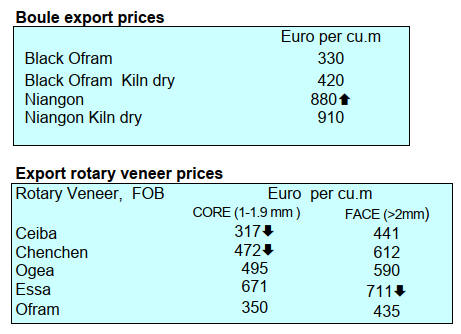
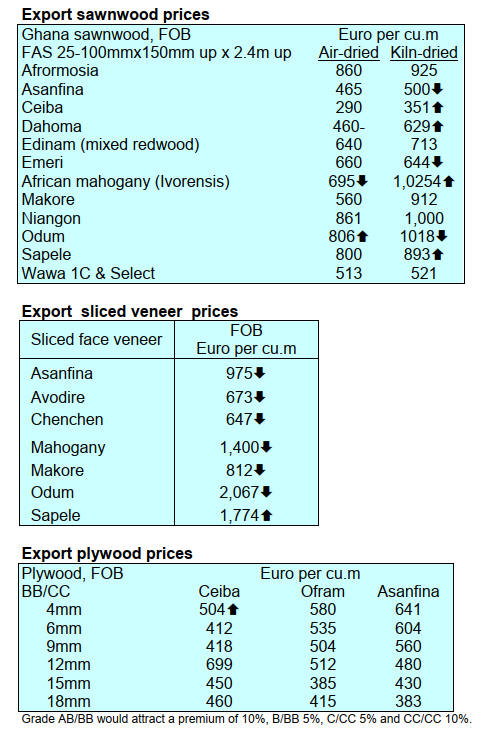
3. MALAYSIA
Ringgit weakening
The big issue at the moment for businesses is the
weakening ringgit and how it will impact the trading
environment. The US dollar/ringgit pair moved above the
4.75 psychological level and rose close to 4.78/dollar.
Behind the change in exchange rates is the growing
strength of the US dollar driven by is position as a safe-
haven in view of the Middle East geopolitical risks. The
other driver is the possibility of another US Federal
Reserve interest rate increase this year. Expectations are
that Malaysian interest rates will be maintained for now to
support domestic demand in view of declining external
trade.
See:
https://www.thestar.com.my/business/business-news/2023/10/21/opr-likely-to-remain-at-3-into-next-year
Adding value to peeler core residues
Sarawak based Samling Group announced it will produce
engineered wood products in cooperation with Loggo IP
Co Ltd, an Australian company. The companies will work
on a pilot project in Sarawak using Loggo IP’s patented
engineered wood technology to process small diameter
peeler cores. It is known that every year tens of thousands
of peeler cores (residues) from plywood production bu are
only used to produce low value products packaging or for
fuel.
In Australia Loggo IP uses acacia and eucalyptus to
produce engineered products for housing, commercial and
government buildings.
See:
http://theborneopost.pressreader.com/article/281702619384272
Furniture design competition
The next Malaysian International Furniture Fair (MIFF) is
scheduled for 1 – 4 March 2024 in Kuala Lumpur and a
furniture design competition is part of the 2024 show.
The MIFF Furniture Design Competition (MIFF FDC)
aims to discover young talent to support Malaysia’s
thriving furniture industry. Organised each year since
2010 in conjunction with Malaysian International
Furniture Fair (MIFF), it offers a platform to emerging
designers to showcase their innovative ideas before a
global audience.
See: https://www.mifffdc.com/about/
Eucalyptus pests invaded Asian eucalyptus
plantations
Demand for wood is expected to increase by four times by
2050 and this comes as the supply from native forests is
decreasing. This will lead to increasing dependence on
industrial tree plantations. To put the issue into perspective
Asia will face an annual deficit of 10 to 17 million tonnes
in wood chips alone.
This was the message from Dr. Simon Lawson, an
Australian professor, in a presentation made in Sabah. He
emphasised the growing importance of pest control in tree
plantations pointing out that a number of herbivore species
from the native range of eucalyptus have invaded many
eucalyptus plantations in Asia over the past 30 years and
there is a risk that pests in eucalyptus plantations can
establish on native tree species.
In related news, a Sabah Forestry Department researcher,
Dr Arthur Y. C. Chung from Sandakan, has been awarded
the 2023 Science and Technology Award by the Malaysia
Toray Science Foundation. This was for his contribution to
the nation’s science and technology through his research
on tropical forest entomology focussing on insect
diversity, insects in nature tourism and forest insect pest
management.
See:
http://theborneopost.pressreader.com/article/281526525737730
MyTLAS promotion
The Malaysian Timber Industry Board has organised a
programme to promote wider use of the Malaysia Timber
Legality Assurance System for Peninsular Malaysia
(MyTLAS), one of the earliest timber legality verification
system developed by Malaysia. MyTLAS has also put in
place comprehensive control procedures to ensure the
exclusion of unverified timber.
MyTLAS complies with a set of principles and criteria
which include the 24 criteria, also known as the MyTLAS
Schedule.
See:
https://www.mtib.gov.my/en/maskayu
Through the eyes of industry
The latest GTI report lists the challenges identified by the
private sector in Malaysia.
See:
https://www.itto-ggsc.org/static/upload/file/20231017/1697507334917952.pdf
4.
INDONESIA
Interest rate increase
Just after Indonesia's surprise interest rate increase in late
October the Philippine central bank also announced an
unexpected rate increase. These moves have highlighted
the challenge Asian central banks face in defending their
currencies and curbing inflation.
See:
https://www.reuters.com/markets/asia/indonesia-cbank-unexpectedly-raises-rates-amid-falling-rupiah-2023-10-19/
Germany welcomes SVLK promotion campaign
Indonesian Deputy Minister of Environment and Forestry,
Alue Dohong, led a delegation to promote Indonesia’s
Legality and Sustainability Verification System (SVLK) to
German wood product importers and representatives of
international trade authorities.
During meetings Acting Director General of Sustainable
Forest Management (PHL), Agus Justianto, said that
Forest Law-Enforcement Governance and Trade
(FLEGT), from which the Timber Legality Assurance
System (TLAS) was developed in Indonesia is known as
the SVLK is an important tool used by the Indonesian
Government and various stakeholders in monitoring and
ensuring the legality of wood products from Indonesia.
The Director of Forest Product Processing and Marketing
Development, Krisdianto, explained the process, which is
transparent, is recorded in the Legality and Sustainability
Information System (SILK) and the data is open to all on
the 'Satu Data PHL' website.
Director Krisdianto added "the flow of wood from the
forest to industrial points is accompanied by a legal
certificate of forest products (SKSHH) and monitored so
that the chain of custody of logs can be followed. We also
carry out a similar process in community forests but of
course in a different way".
The domestic media in Indonesia reported that during the
discussion importers in Germany welcomed the SVLK
promotion campaign and hoped that trade authorities in
every European country would understand the SVLK as an
option in developing a due diligence system related to the
implementation of EUDR.
The German participants were told Indonesian wood
product exporters have questioned the status of the
FLEGT process established between the European Union
and Indonesia. The German State Secretary, Silvia Bender,
said that the German government understands the
problems of implementing the EUDR, especially for small
and medium businesses because the implementation of the
EUDR also has an impact on business actors in Germany.
The German government itself is still reviewing the
implementation of due diligence requirements, she said.
She added that the German government understands the
aspirations of the Indonesian Government and will convey
this at a higher European Union forum.
See;
https://forestinsights.id/wamen-lhk-promosikan-svlk-kepada-importir-jerman-asal-usul-kayu-bisa-ditelusuri/
and
https://www.menlhk.go.id/news/wamen-lhk-diskusikan-flegt-vpa-dan-restorasi-gambut-dengan-pemerintah-jerman/
Productivity boost can come from strong domestic
woodworking machinery sector
The Chairman of the Indonesian Furniture and Crafts
Industry Association (HIMKI), Abdul Sobur, said that
assistance with machinery restructuring and a consistent
supply of raw material will lead to an increase in domestic
sales of furniture and crafts which could reduce the need
for imports. Sobur said that to increase productivity,
efficiency and capacity companies need appropriate
technology.
He added that one of the keys to successful down-
streaming is building a technologically advanced
machinery industry. HIMKI sees China's success in
building productivity because it is supported by very
strong woodworking machinery sector.
Abdul Sobur also pointed out that the furniture and crafts
industry is expanding into new markets in response to
declining demand in Europe and the United States. The
potential markets identified include the Middle East, India,
China, Africa, Japan and other ASEAN member countries.
According to Sobur, a number of countries in the Middle
East such as Qatar, Bahrain, Oman, and the United Arab
Emirates are accelerating infrastructure development
which will have an impact on the need for furniture, crafts
and home décor.
Apart from the Middle Eas,t the next target market is
India, a country with very rapid growth. African markets,
such as Egypt, Morocco and other countries are potential
markets to explore. Meanwhile, the ASEAN market,
including the Philippines, is the next that needs to be
worked on seriously said Sobur.
See
https://agroindonesia.co.id/pelaku-industri-furnitur-garap-potensi-emerging-market/
and
https://www.msn.com/id-id/berita/other/himki-bantuan-restrukturisasi-permesinan-dapat-menahan-laju-impor/ar-AA1ieeGW
Wood pellet factory for Sumatra
A joint venture company will build and operate a
renewable energy biomass business. The company plans to
build and operate a wood pellet factory in Sumatra with
construction to start in early 2024. The company
anticipates production can start in the first quarter of 2025.
Wood pellets play an important role in the green
renewable energy landscape and has broad market
potential amidst global demands to reduce carbon
emissions. The company siad the development of the
wood pellet industry will provide added value, not only to
the company, but more broadly to society and the
environment. In the future, the community will become
one of the partners in supplying raw materials for
production, which in turn is expected to improve social
welfare, community economic resilience, environmental
sustainability and national energy security.
See:
https://swa.co.id/swa/business-strategy/pabrik-wood-pellet-di-sumatera-segera-dibangun-dengan-investasi-us48-juta
In related news the Ministry of Environment and Forestry
(KLHK) continues to promote the cultivation of non-food
biomass industries to produce low-emission energy raw
materials to replace fossil fuels.
During the period 2020-2024 the target area for businesses
to utilise production forests for bioenergy is 15,000
hectares. The KLHK noted that there are 31 units of
Industrial Plantation Forest Timber Product Management
Business Permits (IUPHHK-HTI) and Perum Perhutani
that have supported the development of energy plantation
forests.
Indonesia is striving to accelerate the energy transition
from coal to new and renewable energy through steps
including using wood-based biomass energy as a substitute
for fossil energy. The KLHK supports biomass utilisation
programs by promoting plantation forests for energy
development and optimising wood waste from forests and
the timber industry.
See:
https://en.antaranews.com/news/295746/klhk-encourages-cultivation-of-biomass-plants-to-replace-fossil-energy
Customary forests area reaches 244,000 hectares
The Ministry of Environment and Forestry (KLHK)
reported that the area of customary forests in Indonesia
reached 244,195 hectares as of October 2023. Head of the
Sub-Directorate for Determination of Customary Forests
and Private Forests, Yuli Prasetyo Nugroho, said that the
area is occupied by 131 customary groups.
Most of the inventoried customary forests are on the island
of Kalimantan with the largest in Central Kalimantan
covering an area of 62,426 hectares, followed by West
Kalimantan (50,711 hectares) and East Kalimantan (7,771
hectares).
The establishment of customary forests is believed to be
an important step in ensuring the living space for forest
communities, preserving ecosystems, protecting local
wisdom and traditional knowledge as well as becoming a
pattern for resolving conflicts related to communities in
and around forest areas.
See:
https://www.antaranews.com/berita/3768177/klhk-luas-hutan-adat-kini-capai-244-ribu-hektare
Trade surplus for 41 straight months
Indonesia has maintained a trade surplus for 41
consecutive months even in the face of a declining in
exports. The Central Statistics Agency (BPS) reported that
Indonesia's export earnings in September 2023 amounted
to US $20.76 billion, a 5.6% decrease compared to August
2023. Meanwhile, imports dropped by 8% to US$17.34 billion.
See:
https://jakartaglobe.id/business/indonesia-posts-trade-surplus-for-41-months-in-a-row
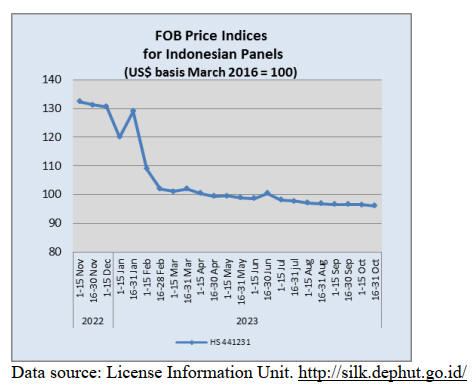
Through the eyes of industry
The latest GTI report lists the challenges identified by the
private sector in Indonesia.
See:
https://www.itto-ggsc.org/static/upload/file/20231017/1697507334917952.pdf
5.
MYANMAR
MTE offers less teak in October tender
According to the MTE website a much lower volume of
teak logs were offered in the October Tender. The offer
was for about 500 tons of teak logs compared to previous
average monthly quantity of 1,000 tons. With export
opportunities severely curtailed millers are facing
considerable challenges and for the first time are seeing
falling orders for the much prized Myanmar natural teak.
Another issue hampering trade is the suspension of online
export document processing, Myanmar TradeNet 2.0, for
companies that were deemed not to have correctly detailed
incoming remittances. This delayed some shipments to
Asian markets.
Some exporters could not settle payments for the logs
purchased from MTE in time and their ‘earnest money’ (or
good faith deposit) of US$10,000 was seized. MTE tender
conditions mention that the ‘earnest money’ will be
confiscated if the payment is not completed within sixty
days.
Recently, a government spokesperson was quoted as
saying export incentives are under consideration.
However, there is a risk that there may not be coordination
between monetary control and export incentives.
See:
https://sso.myanmartradenet.com/?locale=en
Labour shortage
The rubber sector in the south-east region is facing a
labour shortage because workers are moving to
neighbouring countries, mainly Thailand. The local media
has reported there may be as many as 5 million Myanmar
migrant workers in Thailand. In fact, the labour shortage
in Myanmar is not only in rubber plantations but also other
areas including farming. The worker shortage in the rubber
sector is having an impact on the supply of rubberwood.
See-
https://burmese.dvb.no/archives/category/news/economics-new
Pay tax before renewing passports
According to media sources passport renewal by overseas
Myanmarese will be linked to tax payments. The Union
Tax Law 2023 was recently amended to state that income
tax on the salaries of Myanmar workers in foreign
countries must be paid in foreign currency starting
October 2023.
Earlier, the government introduced a rule requiring
workers abroad to remit at least 25% of their foreign-
currency income through the country’s banking system.
The remittances will be converted at the official exchange
rate of 2,100 kyats per US dollar. The market rate is about
3,300 kyats.
Migrant workers who do not comply will be barred from
working abroad for three years after their current work
permit expires. Previous military regimes before 2010 also
levied income tax on Myanmar migrant workers but this
was repealed under the first civilian government of Thein
Sein.
See-
https://www.irrawaddy.com/news/burma/myanmar-junta-demands-expats-pay-tax-before-renewing-passports.html,
https://www.gnlm.com.mm/income-tax-on-salaries-of-myanmar-nationals-working-abroad-must-be-paid-in-foreign-currency-from-october/#
and
https://www.bangkokpost.com/world/2654338/myanmar-slaps-tax-on-migrant-workers-earnings
Myanmar economic forecast
It has been estimated the Myanmar economy grew faster
in FY 2023 (October 2022–September 2023) than in the
previous fiscal year. Business conditions in the
manufacturing sector recovered in October 2022 to
September 2023 period after deteriorating in FY 2022.
Additionally, merchandise exports continued to
expand
robustly year on year in the October-June period.
However, foreign direct investment flows into the country.
Economic activity continues to be stalled by armed
conflict, foreign exchange and trade controls, energy
shortages and sanctions.
See -
https://www.focus-economics.com/countries/myanmar/
6.
INDIA
Inflation cools
The annual rate of inflation in September based on the all
India Wholesale Price Index (WPI) was minus 0.26%
compared to minus 0.52% recorded in August 2023.
Out of the 22 NIC two-digit groups for manufactured
products, 14 groups witnessed an increase in prices in
September whereas 8 groups witnessed decreases in
prices. The month-on-month increase in prices were
mainly contributed by basic metals; other transport
equipment, fabricated metal products, machinery and
equipment, rubber and plastic products. The index for
sawnwood rose while the indices for veneers and panel
products remained flat.
Some of the groups that witnessed a decrease in price were
food products, motor vehicles, trailers and semi-trailers,
electrical equipment, leather and related products,
chemical and chemical products.
See:
https://eaindustry.nic.in/pdf_files/cmonthly.pdf
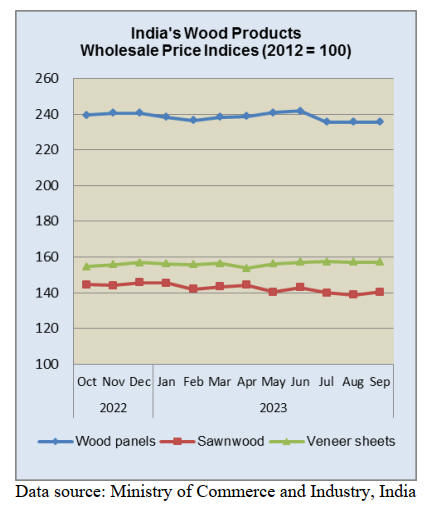
Construction - the third largest sector in India
At a recent construction sector conference participants
learned that with a US$3 trillion GDP India is one of the
largest and fastest growing economies. It is witnessing
massive public investment, robust private consumption
and structural reforms leading to rapid growth.
Construction in India is emerging as the third largest
sector and estimates suggest it could reach US$750 billion
in value in 2024. Urbanisation will contribute over 80% to
GDP by 2050 and analysts say cities need to be receptive,
innovative and productive to foster sustainable growth and
ensure a high quality of living.
The focus of the conference was on steel and concrete for
construction, there was no mention of wood which is
surprising as the conference came on the heels of the
release of a UN report “Building materials and the climate:
Constructing a new future”. This report offers policy
makers, manufacturers, architects, developers, engineers,
builders and recyclers a three-pronged solution to reduce
“embodied carbon” emissions and the negative impacts on
natural ecosystems from the production and deployment of
building materials, cement, steel, aluminium, timber and
biomass.
See:
https://www.unep.org/news-and-stories/press-release/un-plan-promises-massive-emission-cuts-construction-sector-most
and
https://ghtc-india.gov.in/Content/pdf/25-aug-conf/ppt/Emerging-Construction-Systems-for-Mass-Housing.pdf
and
https://ghtc-india.gov.in/Content/pdf/25-aug-conf/ppt/Technology-Transition-through-Light-House-Projects.pdf
Raw material from ‘Trees Outside Forest’ vital for
manufacturers
In a significant development promoting sustainable
management of trees outside of forests in India the
Network for Certification and Conservation of Forests
(NCCF), the National Governing Body in India, has
secured full endorsement of the Trees outside Forest
Certification System (ToFSTD) by the Programme for the
Endorsement of Forest Certification (PEFC).
This provides the foundation for certification of wood-
based raw material originating from Tree outside Forests
(ToF). Currently Indian wood-based industries procure
75% of their wood-based raw materials from ToF, 5%
from native forests and the balance from imports.
The NCCF, along with other key stake holders in the
industry have been working towards the development of a
country-specific certification scheme since 2016.
See:
https://plyinsight.com/nccf-achieves-100-approval-for-tof-scheme-endorsement-by-pefc/
Veneer prices set to rise
PlyReporter, in its latest magazine, says production of face
veneer by mills operating in the Gabon Special Economic
Zone, NKOK has dropped due to industrial unrest. If this
continues the supply of veneer will fall and prices will
rise. PlyReporter forecasts that falling output set against
steady demand could push up prices of okoume veneer by
15-20%.
There are over 40 veneer and plywood manufacturing
companies established in Gabon through considerable
investments from Indian companies.
See:
https://www.plyreporter.com/current-issue#
NZ/India log trade to resume
A resumption of the New Zealand log trade with India
may soon be possible. New Zealand did have a modest log
export trade with India (about 1.7 million cubic metres a
year) but the implementation of a ban in NZ on the use of
methyl bromide fumigant as a log treatment brought
exports to an end because Indian regulations stipulate
methyl bromide must be used with no alternatives
proposed.
Recently the Indian authorities updated the phytosanitary
requirements for Indian log imports, allowing fumigation
of logs in ships holds on arrival in India in lieu of
treatment prior to sailing from NZ. A trial is underway.
See:
https://www.farmersweekly.co.nz/markets/rule-change-on-logs-could-kickstart-india-trade/
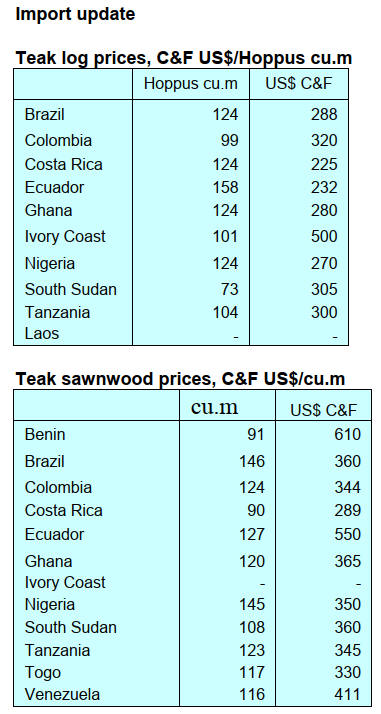 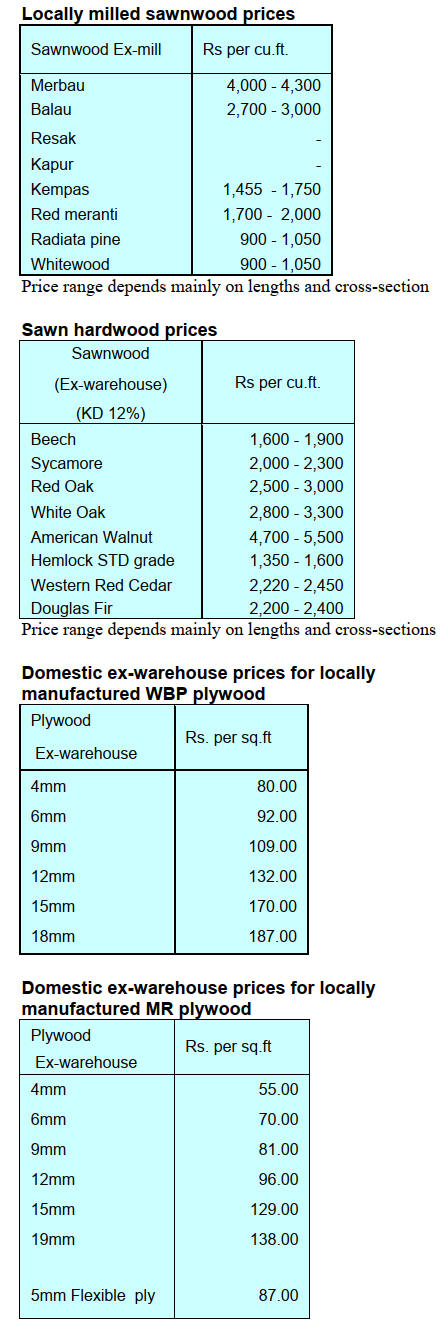
7.
VIETNAM
Wood and Wood Product (W&WP) trade highlights
According to the General Department of Customs,
W&WP exports to the Australian market in September
2023 amounted to US$13.2 million, down 11% compared
to September 2022. In the first 9 months of 2023 W&WP
exports to Australia reached US$105.4 million, down 30%
over the same period in 2022.
In September 2023 bedroom furniture exports were valued
at US$141 million, down 11% compared to September
2022. In the first 9 months of 2023 exports of bedroom
furniture earned US$1.2 billion, down 35% over the same
period in 2022.
Vietnam's poplar wood imports in September 2023 were
30,800 cu.m, worth US$11.7 million, up 4% in volume
and 2.5% in value compared to August 2023. Compared to
September 2022 imports dropped 9% in volume and 31%
in value. In the first 9 months of 2023 poplar imports
reached 235,200 cu.m, worth US$97.8 million, down 19%
in volume and 33% in value over the same period in 2022.
Raw wood (logs and sawnwood) imported from China into
Vietnam in September 2023 amounted to 45,000 cu.m, at a
value of US$21.0 million, down 11% in volume and 4% in
value compared to August 2023. Over the first 9 months of
2023 the raw wood Vietnam imported from China totaled
380,940 cu.m with a value of US$190.74 million, down
27% in volume and 39% in value over the same period in
2022.
Wood processors awaiting market recovery
Vietnamese wood businesses are facing countless
difficulties due to a lack of orders, rising costs and slow
VAT tax refunds. Many have scaled back operations as
they wait for the market to recover.
The latest statistics from Vietnam Customs show that in
the 12 months to 15 September Vietnam’s total export
value reached US$242.04 billion, down US$23.44 billion
or 9% year-on-year. Of which, shipments of wood and
wood products fetched US$9.01 billion, a decrease of 23%
compared to the figure of US$11.67 billion achieved in the
same period last year.
Vietnam’s wood industry is targeting exports of US$17
billion in 2023. However, exports of wood and wood
products have been slow this year with most businesses
facing a shortage of orders.
In the first eight months of 2023 Vietnam's exports of
wood and wood products reached about US$8.3 billion,
down nearly 26% year-on-year.
"Since May 2023 Vietnam's exports of wood and wood
products have shown signs of a recovery, with over
US$1.2 billion in exports per month on average.
Meanwhile, Vietnamese raw wood imports have climbed
5-10% per month.
This shows that wood producers are preparing for year-
end orders said Nguyen Chanh Phuong, Vice Chairman of
HAWA.
He predicted that exports in the final quarter of this year
could bring home an additional US$6 billion raising the
total exports in 2023 to between US$14-14.5 billion.
Regarding the recovery prospects of the wood industry a
representative of Thien Thanh Phat Timber Co., Ltd said
that the wood industry is completely dependent on
international markets. When the world economy remains
unsettled the Vietnamese wood industry struggles.
According to Le Hoang Hai, director of CMH Vietnam
Import-Export Trading Co., Ltd., there are signs of uneven
recovery in the wood industry reflected in the irregular
number of orders while at the same time raw material
prices are escalating.
"The current wood market is unpredictable, with unstable
prices and orders. For example, to produce domestic
furniture we need to buy wood. But furniture orders are
irregular with only short-term orders of two or three
months causing difficulties for the balancing of production
materials.
The recovery of the wood market depends much on the
real estate industry which is forecast by the Vietnam
National Real Estate Association to remain quiet until the
end of 2023 and only recover and develop healthier from
the second or third quarter of 2024, thanks to legal
improvements, economic growth and removal of financial
bottlenecks.
In addition, many wood businesses revealed that one of
the current difficulties is the delay in refunding value-
added tax (VAT). In fact, many of them have had tax
refunds delayed for two years in a row which disrupts their
financial planning.
See:
https://theinvestor.vn/vietnam-wood-processors-await-market-recovery-d6746.html
Improvement in exports to the US
Wood product exports to the US are warming up although
sales over the past few months were down compared to the
same period last year.
The Ministry of Industry and Trade's Agency for Foreign
Trade Information Center reports the US remained the
main market for Vietnamese wood. In the first half of
2023 exports reached US$3.3 billion, accounting for 54%
of the total but down 33% over the same period in 2022.
The driver of demand growth in the US market is low
inventories and increased construction activity.
Furthermore, the market becomes more active as the
holiday shopping season approaches.
Low availability of housing combined with the numerous
incentives offered by construction companies has
increased buyer interest in new homes which has lifted
demand for imported wood and wood products particularly
wooden furniture.
The U.S. economy is showing signs of revival with
consumer demand increasing. The U.S. government and
its corporations continue to pay attention to Vietnam and
pledge robust business collaboration. As a result of the
positive rebound, big US retail chains have begun to
resume orders with Vietnam.
According to Tran Lam Son, Deputy General Director of
Thien Minh Import-Export Co., Ltd., the US market is
exhibiting signs of improvement. Thien Minh specialises
in plantation wood as well as bamboo and rattan.
Two years ago the Japanese market accounted for
approximately 50-60% of this enterprise's overall export
earnings while the US accounted for approximately 40%.
However, the U.S. market currently accounts for
approximately 50–60% of the company's overall export
revenue.
Son said that, while shipments to the US were still down
from the previous year, orders were up because clients
were gearing up for the holiday shopping season.
He noted that during peak times, shipping costs to the US
were more than US$10,000 per container but that cost has
fallen which allowed more competitive pricing.
According to a representative of Bao Hung Co., Ltd., a
manufacturer of wooden furniture, shipments to Japan
accounted for 60% of its total export revenue two years
ago, while the U.S. accounted for 40%. Now, 60-70% of
exports are to the U.S. The U.S. market gained somewhat
due to end-of-year imports while the Japanese market
remained stagnant.
See:
https://theinvestor.vn/wood-exports-to-the-us-warming-up-association-d6153.html
Building a brand
In the context of an increasingly difficult and challenging
world market, building a brand for Vietnamese wood and
bringing higher value to wooden and interior products is a
"problem" that businesses face.
In addition to meeting the average domestic consumer
demand of about US$3-4 billion/year, Vietnam's wood
industry exports an average of over US$15 billion each
year, making Vietnam the 5th largest W&WP exporter.
Currently, the export markets for Vietnamese wooden
furniture have expanded from 60 countries and territories
in 2008 to over 120 countries and territories in 2022.
Although wooden furniture has a solid foothold in the
domestic market, strong brands in Vietnamese wood and
furniture such as Hoang Anh Gia Lai Wood Joint Stock
Company (Gia Lai), An Cuong Wood Joint Stock
Company (Binh Duong) ), Thuan An Wood Joint Stock
Company (Binh Duong) has still not been able to make a
mark in the international.
Most Vietnamese wood products have only won the trust
of wholesalers and foreign agents but are almost
"unknown" to the final consumer.
According to the General Department of Forestry the
cause of this situation is that the policy to develop the
wood processing industry's brand has not been
implemented. Meanwhile, Vietnamese wood and wood
product businesses do not have experience and do not have
enough resources in terms of capital, people and
management qualifications to develop an overseas sales
system, a foundation to build a brand.
Developing overseas markets requires large-scale
production capacity and few Vietnamese enterprises can
meet this requirement.
Mr. Nguyen Quoc Khanh, Chairman of the City
Handicraft and Wood Processing Association ( Ho Chi
Minh HAWA) and Chairman of the Board of Directors of
AA Company said it is time for Vietnamese businesses to
change their thinking of making money by diligence in
production, taking work as profit but need to build their
own brand.
Branding will help businesses develop vision, direction,
increase customer base, easily access international markets
and optimise profits.
The brand itself will increase commercial value not only
contributing to increasing export turnover and domestic
wholesale value but also positioning Vietnam's wooden
furniture industry on the world map.
Through building brands for themselves businesses will
contribute to creating a brand for the Vietnamese wood
industry.
At the workshop "Bringing Vietnamese fashion, furniture
and household goods into the foreign distribution system"
recently organised by the European-American Market
Department (Ministry of Industry and Trade) Nguyen
Chanh Phuong, Deputy Chairman and Secretary General
of HAWA emphasised that Vietnam has the advantage of
a complete, sustainable supply chain in terms of policies
people, and raw material supply.
But to promote the export of Vietnamese wood products
and furniture more effectively it is necessary to form a
logistics and trade promotion center for Vietnamese
furniture. In terms of market, businesses need to break
away from traditional markets and target markets with
good purchasing power such as Canada, England, Japan,
Korea, India and Saudi Arabia.
At the same time, the timber and furniture industries also
need to actively expand online exports and exports by
projects. Promoting the promotion of national furniture
brands at international furniture fairs is a strategy that
Vietnamese businesses need to focus on for highly
effective trade promotion.
Assessing the challenges of Vietnam's wood industry, Mr.
Eryk Dolinski, Director of Wood Product Business
Development, Supply Department of IKEA Group in
Southeast Asia said that Vietnam's wood processing and
furniture industry is still highly labour-intensive and raw
material sources are mainly located in small farmers so
origin is difficult to trace.
To solve the above problems, Mr. Dolinski said that the
wood products and furniture industries need to focus on
investing in automation to help increase production
efficiency and product quality.
Automation not only in the factory but throughout the
supply chain to meet the increasing demands of the
market. At the same time, we must create a better working
environment and reduce carbon emissions;
And increase efficiency in wood origin certification.
Optimising the supply chain from raw material
transportation, sawmills to production and transportation
stages must be focused on to maximise savings on raw
materials, energy and logistics costs.
With the burden of origin and quarantine, Vietnam needs a
different approach in exporting wood and wood products.
In addition, businesses need to invest more in production
to have green, clean production processes and reduce
emissions to keep up with increasing demands from
buyers.
See:
https://www.vietnam.vn/en/dinh-vi-thuong-hieu-go-viet-khi-ra-bien-lon/
Rubber Group Green Growth Development Strategy
According to Le Thanh Hung, General Director of the
Vietnam Rubber Group (VRG) the Group always
determines its pioneering role in developing the rubber
industry. The new Green Growth and Sustainable
Development Strategy is one of the Group's important
guidelines to simultaneously implement three goals:
economic development, environmental protection and
responsibility towards the community and society.
Accordingly the strategy was built to meet the sustainable
development trend of Vietnam and the world, contributing
directly to reducing greenhouse gas emissions towards a
long-term carbon-neutral economy.
Greening the supply chain
Specifically, the target for 2030 is to reduce greenhouse
gas emissions in energy activities by at least 15%
compared to 2023 and by 2050 reduce greenhouse gas
emissions in energy activities by at least 30% compared to
2023.
From there, it is possible to meet the increasingly high and
demanding requirements of customers, especially the
requirements of tire manufacturers, wood processers,
industrial rubber producers, etc., as well as meet policies
to only purchase natural rubber from companies
committed to ensuring sustainability throughout the entire
supply chain.
VRG continues to implement national and international
certifications on sustainable development towards the goal
of the business committing to sustainable supply, having
transparent traceability policies, completing the
governance system and improving business standards for
international integration.
Regarding the supply chain the Group sets a goal that by
2030, 60% of rubber areas and production forests will
achieve national and international sustainable forest
management certifications (VFCS, PEFC, FSC, etc.), and
100% of latex processing factories will achieve the chain
of custody certificate.
From the moment the European Commission (EC)
proposed the EUDR the Ministry of Agriculture and Rural
Development (MARD) and the Vietnam Rubber Group
(VRG) directed relevant units to focus on monitoring and
controlling the growing area to avoid deforestation and
forest degradation.
See:
https://vietnamagriculture.nongnghiep.vn/vrg-finalizes-its-green-sustainable-growth-strategy-d363947.html
8. BRAZIL
Biomass survey of the
Amazon rainforest
A biomass map of the Brazilian Amazon from multisource
remote sensing, conducted by INPE (National Institute for
Space Research), resulted in the creation of the largest
above-ground biomass map of the Amazon Forest. This
map was generated by combining aerial scans with
airborne lasers, satellite images and geolocation field
inventories, integrated by heavy computational processing
with machine learning.
The study estimated the total biomass of the Amazon
rainforest based on the mapping of 3,600 square
kilometers through transects distributed across all the
region's vegetation categories. It showed an average
biomass concentration of 174 tonnes per hectare and a
maximum of 518 tonnes per hectare, providing crucial
data for planning policy, conservation and sustainable
management, especially at a critical time for the Amazon
due to concerns about carbon emissions and loss of
biomass due to deforestation.
In deforested areas, cross-referencing map data with
deforestation information provided by INPE's Prodes
system makes it possible to calculate the loss of biomass
with greater precision.
The research is relevant in the context of the
environmental crisis in the Amazon and has significant
implications for decision-making regarding forest
conservation and climate change mitigation.
See:
https://www.remade.com.br/noticias/19527/mapa-mostra-levantamento-da-biomassa-da-floresta-amazonica
Technical standard for light wood frame buildings
Wood frame construction, an industrialised construction
system, is common in countries such as the United States,
Canada, Germany, Finland and Sweden and this
construction method is gaining importance in Brazil,
especially after the approval of the new ABNT (Brazilian
Association for Technical Standards / Associação
Brasileira de Normas Técnicas) regulating wood frame
construction in the country.
Wood frame combines construction efficiency,
versatility
and energy benefits, aspects that are increasingly valued in
the civil construction industry. In addition, this system
offers a solution to Brazil's housing shortage.
The ABNT NBR 16936 technical standard which regulates
light wood frame buildings is the result of an extensive
collaborative effort involving associations, universities,
companies in the timber industry, system suppliers and
construction companies.
With this regulation the sector now has technical
guidelines to ensure the quality and safety of buildings
built with this system for up to two-storey building,
representing an important milestone for the civil
construction industry in Brazil.
However, challenges such as public policies, inclusion of
the construction system in financing credit lines and a
coordinated communication campaign presenting its
differentials and benefits should be addressed in order to
boost the growth of wood frame in the country.
See:
https://www.remade.com.br/noticias/19514/entenda-a-norma-abnt---edificacoes-em-light-wood-frame
Export update
In September 2023 the value of Brazilian exports of wood-
based products (except pulp and paper) decreased 24% in
value compared to September 2022, from US$341.3
million to US$259.7 million.
Pine sawnwood exports declined 41% in value between
September 2022 (US$69.6 million) and September 2023
(US$41.3 million). In volume, exports dropped by 25%
over the same period, from 242,300 cu.m to 182,000 cu.m.
Tropical sawnwood exports decreased 25% in volume,
from 30,800 cu.m in September 2022 to 23,000 cu.m in
September 2023. In value, exports decreased 31% from
US$14.8 million to US$10.2 million, over the same
period.
In contrast, pine plywood exports saw a 14%
increased in
value in September 2023 compared to September 2022,
from US$41.6 million to US$47.4 million and in volume,
exports increased 34% over the same period, from 114,100
cu.m to 153,400 cu.m.
However, tropical plywood exports decreased in volume
39% and in value by 48%, from 3,300 cu.m and US$2.3
million in September 2022 to 2,000 cu.m and US$1.2
million in September 2023, respectively.
Wooden furniture export earnings in September dropped
from US$53.8 million in September 2022 to US$ 47
million in September 2023, a 13% fall.
Paricipation in Macau Forum
Entrepreneurs from the forest sector in the state of Mato
Grosso in the Amazon Region are preparing to take part in
the Global Legal and Sustainable Timber Forum (GLSTF)
2023 to be held 21-22 November in Macau, China.
This event represents a valuable opportunity for the forest
sector to access new markets, expand business and
diversify sales of native timber species on the international
market. The Center of Timber Producing and Exporting
Industries of the State of Mato Grosso (CIPEM) discussed
the importance of participation of forest companies in this
event with its members from the eight forestry unions.
CIPEM considers the GLSTF an important agenda for the
forest sector as it is specific to the segment and more than
300 forest products importers are expected to participate in
the event facilitating direct contact with clients and
strengthening business relationships.
The Chinese market is an important consumer of wood
products coming from sustainable forest management
areas. In the first eight months of 2023 forest-based
companies of the state of Mato Grosso exported 7,784
tonnes of wood to China.
This volume represents 13% of the total (62,000 tonnes)
traded by industries in Mato GrossoSstate, with a turnover
of US$5.8 million, equivalent to 9% of the US$64.9
million earned from the State's wood product exports
according to the Ministry of Agriculture and Livestock
(MAPA).
The participation of entrepreneurs from Mato Grosso State
at the GLSTF is important because there is an opportunity
to show that the state has a high production volume,
product quality and traceability and has joined efforts to
consolidate the State's position in the international market.
See:
https://forestnews.com.br/industrias-mato-grosso-forum-global-da-madeira/
Latin America conference discusses SFM
The opening of the IUFRO (International Union of Forest
Research Organizations) 2023 Latin America Conference
was attended by the conference's Organizing and Scientific
Committee emphasising the importance of the diversified
programme to reflect on sustainable management in
natural and planted forests and the sustainable use of
timber as a renewable raw material.
Genetic improvement, planting trees to absorb carbon
emissions, new uses for planted forests with renewable
and sustainable raw materials were among the priority
topics.
In addition, the conference emphasised the importance of
forests in the context of the Sustainable Development
Goals, addressing issues such as food security, sustainable
agriculture and environmental management, while also
promoting collaboration among various stakeholders to
boost the country's economic growth through solid
partnerships, including the internationalisation of
knowledge in the area of forestry.
Brazil plays an important role in environmental
sustainability management which is essential for biosafety
especially in relation to research into genetically modified
organisms according to EMBRAPA (Brazilian
Agricultural Research Corporation). Sustainably managed
natural and planted forests have become sources of energy
generation, manufacture of timber products and economic
growth, resulting from national and international
cooperation.
See:
https://www.embrapa.br/florestas/busca-de-noticias/-/noticia/84134935/manejo-sustentavel-de-florestas-e-tema-de-conferencia-iufro-2023-america-latina
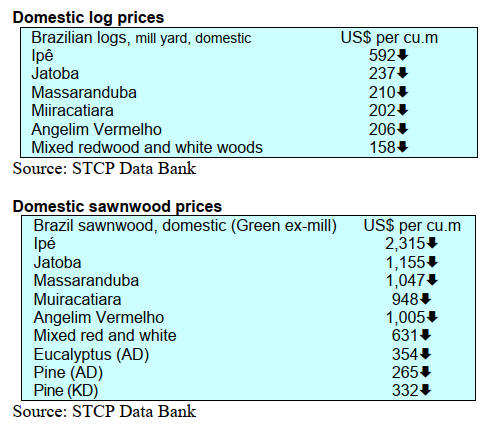
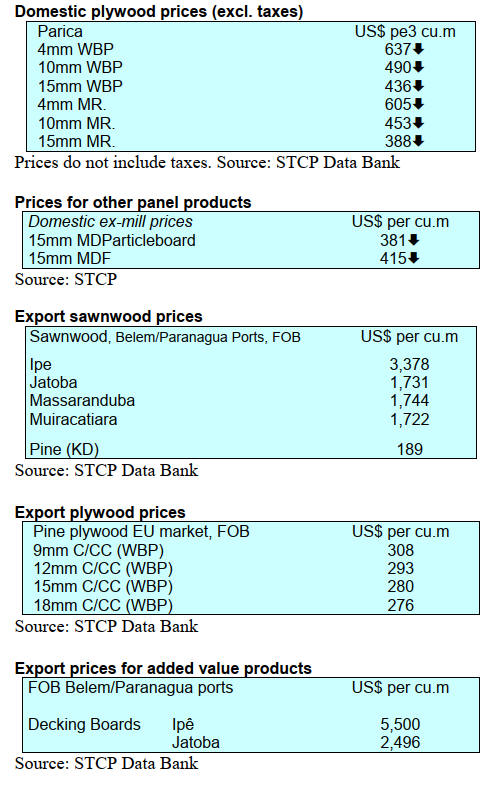
Through the eyes of industry
The latest GTI report lists the challenges identified by the
private sector in Brazil.
See:
https://www.itto-ggsc.org/static/upload/file/20231017/1697507334917952.pdf
9. PERU
Bill presented for
development of the forest industry
Peru has about 72 million hectares of natural forests and
according to Antonio Castillo of the Garay Institute of
Economic Studies, National Society of Industries (SNI), of
this 7 million hectares are feasible for the development of
the forest industies.
He explained that currently around 500,000 ha. of
operationing concessions generate wood products worth s
between US$125 million and US$130 million in exports
despite the problems that the sector has such as poor
traceability and lack of financing.
He added that through SFM and robust traceability exports
can grow and jobs can be created. Castillo said that the bill
that the SNI has prepared focuses on forestry sector
development.
B-to-B with foreign buyers
During an October business conference held in Pucallpa
169 business-to-business meetings were arranged for
manufacturers and buyers of sawnwood, flooring,
moldings, boards, beams, doors, finger joint boards among
others.
Foreign buyers had the opportunity to check the quality of
the Peruvian timber and commitments for trade to the
value of US$8 million were made wit some US$600,000
immediate sales contracts signed.
Ten buyers from South Korea, the United States, Mexico
and the Dominican Republic and 25 exporting companies
from Ucayali, Loreto and Lima participated bringing
together in one place wood producers, processors,
exporters, importers, distributors, investors and other
professionals related to the value chain of the sector and
its products.
The Peruvian companies pointed out they have sustainable
management certifications ensuring environmentally
sound and legal production.
See:
https://agraria.pe/noticias/compradores-extranjeros-demandaron-oferta-maderera-por-us-8--33524
Government allocation to promote forestry sector
The Ministry of Economy and Finance (MEF) approved
the transfer of US$ 1.3 million to the National Forestry
and Wildlife Service (Serfor) to finance the additional
goals of interventions that promote the forestry and
wildlife sector.
According to Supreme Decree 223-2023-EF, published in
the Official Gazette El Peruano the resources will be taken
from the MEF Contingency Reserve. The supreme decree
is endorsed by the President of the Republic, Dina
Boluarte and the Minister of Economy and Finance, Alex
Contreras.
See:
https://agraria.pe/noticias/ejecutivo-destina-s-4-9-millones-para-impulsar-sector-forest-33569
Illegal logging and timber trade – a decline in 2019
Efforts made by the Forest and Wildlife Resources
Supervision Agency (Osinfor) have resulted in a reduction
in the rate of illegal logging and trade in illegal wood.
This is the conclusion of the study "Estimation of the
Illegal Logging and Timber Trade Index in Peru in 2019"
carried out jointly by OSINFOR, the Regional and
Wildlife Authorities (ARFFS) and the National Forest and
Wildlife Service (Serfor) with technical support of the
FOREST+, a programme of USAID and the US Forest
Service.
With the data provided by the study, regional and national
forestry authorities, as well as decision makers in the
sector, will have a clearer understanding of the existing
weaknesses within their powers.
In addition, it establishes a concrete framework for action
to combat illegal logging as they carry out their functions
and design improved public policies, in order to strengthen
efforts to combat illegal logging and move towards
sustainable forest management in Peru.
See:
https://www.gob.pe/institucion/osinfor/noticias/852223-tala-y-comercio-ilegal-de-madera-se-redujo-en-2019-de-acuerdo-con-estudio-del-osinfor
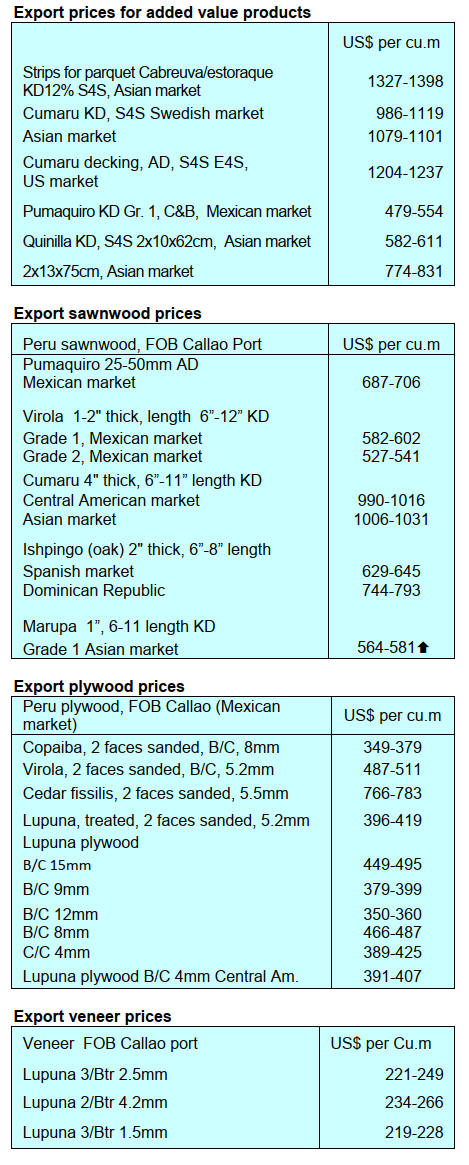
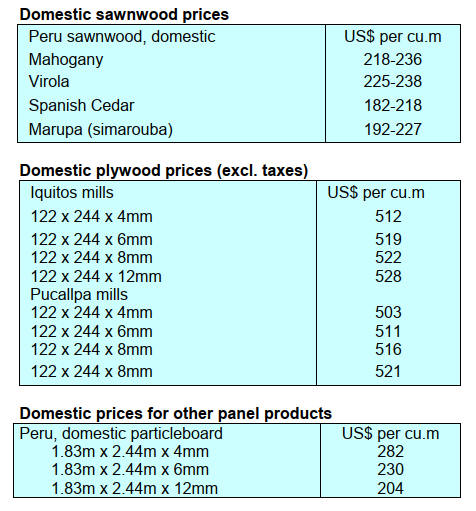
|